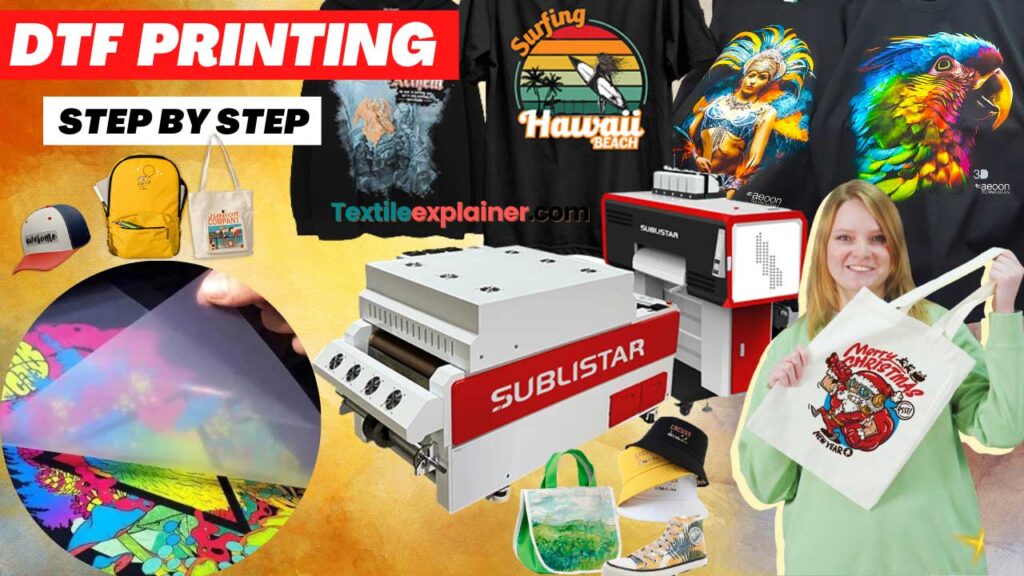Utilizing the Power of DTF Printing: Strategies for High-Quality Fabric Styles
Utilizing the Power of DTF Printing: Strategies for High-Quality Fabric Styles
Blog Article
Ultimate Guide to DTF Printing Techniques for Stunning Fabric Layouts
Starting the trip of understanding DTF printing techniques can open a world of opportunities for developing visually captivating fabric designs. As the textile industry proceeds to progress, staying in advance of the curve with cutting-edge printing techniques is essential. In this guide, we will certainly explore the detailed details of DTF printing, from comprehending the essential essentials to unraveling progressed shade methods that can elevate your layouts to new heights. Keep tuned as we explore the subtleties of picking the best materials, refining the printing procedure, and getting rid of typical difficulties to accomplish stunning results.
Understanding DTF Printing Essentials
DTF printing, a procedure that entails transferring layouts from a special film to textiles utilizing warmth and stress, forms the structure of fabric printing techniques. This innovative method enables top notch, vivid styles to be perfectly transferred onto various textiles with accuracy and detail. The very first step in DTF printing involves creating or choosing a layout that will be printed onto the textile. This layout is after that printed onto a special movie using a DTF printer, which uses details dyes or pigments to guarantee color precision and sturdiness.
The final outcome is a spectacular, lasting fabric layout that is washable, adaptable, and resistant to fading. In general, recognizing the essentials of DTF printing is crucial for understanding this modern-day fabric printing method.
Choosing the Right Fabric Products
Having actually established the fundamental principles of DTF printing strategies for textile layouts, the following important factor to consider hinges on selecting the suitable fabric products to enhance this innovative procedure effectively. The success of a DTF print greatly depends upon the compatibility in between the selected textile and the printing method. When selecting textile materials for DTF printing, it is essential to think about the material's composition, weave, and structure. Fabrics that work well with DTF printing consist of polyester blends, spandex, nylon, and various other synthetic materials. These fabrics usually have a smooth surface area that enables detailed and vivid prints. Additionally, the stretchability of these materials can fit the heat transfer procedure associated with DTF printing without misshaping the style. It is recommended to prevent all-natural fibers such as cotton or silk, as they might not produce the same level of print clarity and sturdiness. By picking the best fabric products, developers can maximize the capacity of DTF printing to create spectacular and long-lasting textile designs.

Understanding the Printing Refine
To stand out look at this web-site in DTF printing techniques for textile styles, understanding the printing process is essential for achieving top notch and constant outcomes. The temperature, pressure, and duration of warm application must be very carefully managed to make sure correct bond of the layout to the fabric. By honing each of these steps in the printing process, developers can regularly generate spectacular and long lasting textile styles with DTF printing strategies.
Enhancing Designs With Shade Techniques

Moreover, explore color slopes can bring a feeling of movement and fluidness to the design. By blending shades flawlessly, a gradient effect can be achieved, including a dynamic and modern-day touch to the textile style. In addition, making use of shade blocking strategies can create bold and striking visuals by comparing different solid colors in unique sections of the style.
Additionally, integrating metallic or neon shades can provide a attractive and distinct element to the textile style, making it attract attention and radiate a feeling of vibrancy. When purposefully applied, these color techniques can raise the overall visual allure of textile styles, making them more remarkable and exciting.
Troubleshooting Common DTF Printing Issues
After checking out numerous color strategies to improve textile layouts, it is necessary to address typical DTF printing issues that may emerge during the manufacturing process. One common concern is poor bond, which can arise from incorrect healing temperature levels or times. To resolve this issue, about his ensure that the healing setups are accurate which the adhesive utilized is ideal for the particular fabric being published on. Another regular obstacle is color incongruities, where colors might appear differently than expected. This can be caused by wrong color accounts or settings in the printing software. To tackle this, ascertain the shade setups and accounts to guarantee they match the desired layout. In addition, issues with image clarity and sharpness Recommended Reading can happen because of low-resolution photos or inappropriate printing techniques. To address this, always use top notch images and readjust the printing setups for optimum clearness. By recognizing these typical troubles and carrying out the needed troubleshooting actions, you can improve the general high quality of your DTF printed textile layouts.
Final Thought
In final thought, understanding DTF printing strategies is necessary for creating spectacular textile layouts. With practice and attention to detail, one can develop stunning and special textile layouts utilizing DTF printing strategies.
Styles))))
DTF printing, a process that includes moving layouts from an unique movie to textiles using heat and pressure, creates the foundation of fabric printing strategies.Having developed the foundational principles of DTF printing strategies for textile layouts, the following important consideration lies in selecting the ideal fabric products to enhance this ingenious procedure efficiently. By choosing the best fabric products, developers can maximize the capacity of DTF printing to produce resilient and sensational textile layouts.
To excel in DTF printing techniques for textile layouts, grasping the printing process is essential for accomplishing premium and constant outcomes. DTF Printing. By sharpening each of these actions in the printing process, designers can regularly generate durable and spectacular fabric designs with DTF printing strategies
Report this page